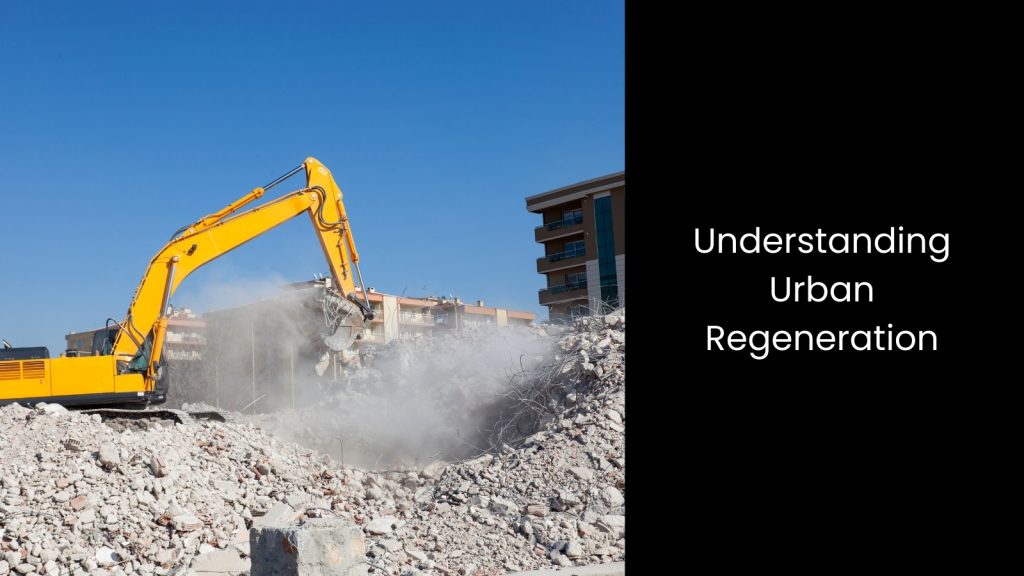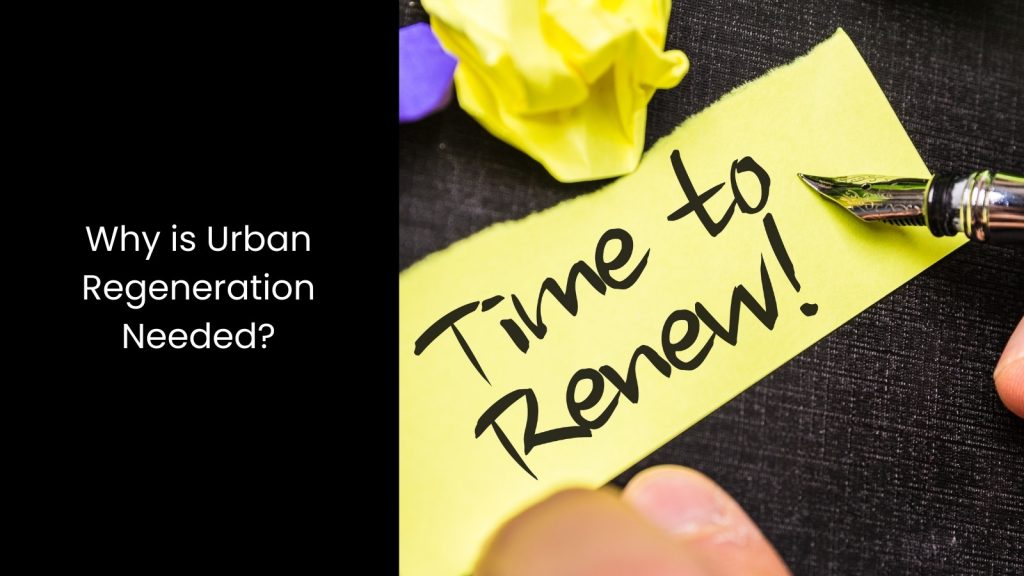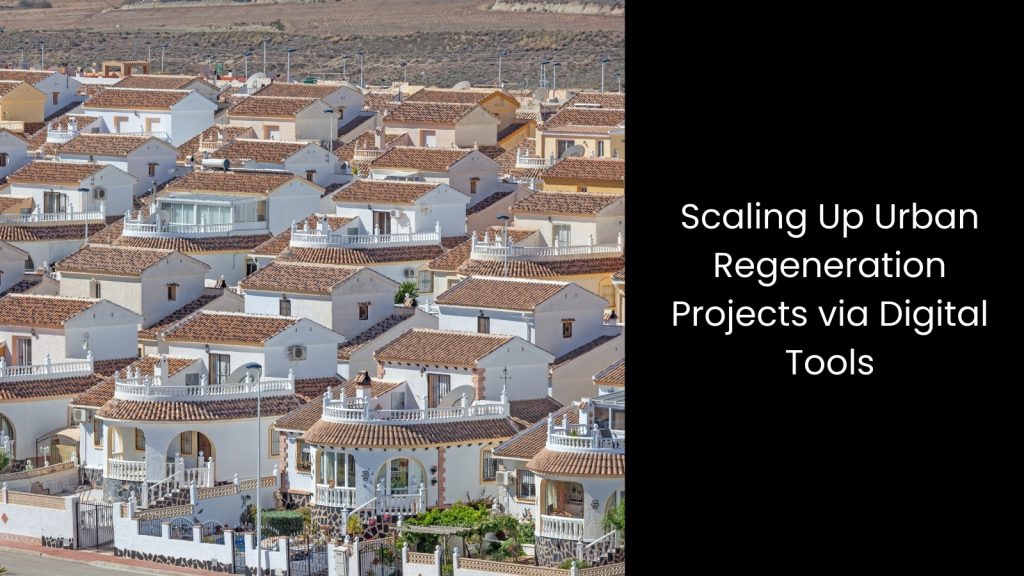In the talks of urbanisation, one aspect that has emerged as a novel yet powerful is ‘Urban Regeneration’. This simply sparks life into neglected spaces, turning forgotten corners of cities into blooming fountains of opportunity. It is more than construction or renovation; it is a bold reimagination of what urban spaces can become. As cities expand and populations grow, the need for smarter, more inclusive spaces becomes undeniable. Urban regeneration should not be misunderstood as just a repair. It is a ‘reinvention’ to connect people, create jobs, smartly and redefine how communities live, work, and interact.
In this article, we explore the concept of ‘Urban Regeneration’ and how it will benefit countries in different approaches.
In this article, we explore the concept of ‘Urban Regeneration’ and how it will benefit countries in different approaches.
Understanding Urban Regeneration

- Urban regeneration is a process that transforms neglected or declining urban areas into vibrant, functional, and sustainable spaces that benefit the community. This process involves reimagining land use, upgrading infrastructure, improving public services, and creating spaces that support economic, social, and environmental growth.
- The main reason for developing this concept is that cities face challenges like overcrowding, outdated infrastructure, or abandoned buildings, and urban regeneration offers practical solutions by breathing new life into these areas. It focuses on redeveloping underutilised spaces, building affordable housing, and enhancing transportation networks, which in turn boosts local businesses and job opportunities.
- This approach also helps cities handle population growth efficiently without expanding outward, preserving natural surroundings. When focusing on long-term development, urban regeneration supports sustainability, preserves cultural heritage, and transforms once-forgotten neighbourhoods into thriving hubs.
- Whether it is a city centre or a suburban area, the process of urban regeneration reshapes spaces to meet the needs of today’s communities better, promoting connectivity, opportunity, and a better quality of life for everyone.
Why is Urban Regeneration Needed?

It Combats Urban Sprawl
This strategy helps combat urban sprawl, which is the unchecked development spread into surrounding rural or green areas. This situation usually leads to inefficient land use and environmental degradation. Urban sprawl happens when cities prioritise outward expansion over thoughtful urban planning, resulting in scattered housing, roads, and commercial buildings that strain resources and increase dependence on vehicles.
This is when urban regeneration takes a smarter approach by redeveloping underutilised spaces within the city, such as abandoned factories, vacant lots, or outdated neighbourhoods. It transforms these areas into functional spaces for housing, commerce, and public amenities, making better use of existing land and reducing the need for outward growth.
Through urban regeneration, cities modernise infrastructure, improve public transport systems, and create walkable communities, which attract people to live and work within city boundaries. This approach preserves green spaces, farmland, and wildlife habitats while also cutting down on pollution and long commutes caused by urban sprawl.
It is visible that urban regeneration ensures that cities grow responsibly, meeting the needs of their populations without sacrificing the environment or wasting resources. It encourages smarter city development, creates inclusive spaces, and prevents the uncontrolled expansion that defines urban sprawl, making urban areas more livable and sustainable for everyone.
This is when urban regeneration takes a smarter approach by redeveloping underutilised spaces within the city, such as abandoned factories, vacant lots, or outdated neighbourhoods. It transforms these areas into functional spaces for housing, commerce, and public amenities, making better use of existing land and reducing the need for outward growth.
Through urban regeneration, cities modernise infrastructure, improve public transport systems, and create walkable communities, which attract people to live and work within city boundaries. This approach preserves green spaces, farmland, and wildlife habitats while also cutting down on pollution and long commutes caused by urban sprawl.
It is visible that urban regeneration ensures that cities grow responsibly, meeting the needs of their populations without sacrificing the environment or wasting resources. It encourages smarter city development, creates inclusive spaces, and prevents the uncontrolled expansion that defines urban sprawl, making urban areas more livable and sustainable for everyone.
It Helps Adapting to Population Growth
This process plays a vital role in helping countries adapt to population growth by making cities more efficient, resourceful, and livable.
As populations grow, cities struggle with overcrowding, housing shortages, and stretched infrastructure. Urban regeneration directly addresses these issues by repurposing abandoned buildings, empty lots, and outdated industrial sites into spaces that accommodate new housing, businesses, and public services. It focuses on creating compact, well-planned neighbourhoods where residents can live, work, and access amenities without contributing to urban sprawl.
This process upgrades existing infrastructure, such as water systems, public transport, and energy grids, to handle the increased demand that comes with population growth. It also prioritises sustainable development, adding green spaces, walkable streets, and energy-efficient buildings, which improve quality of life while reducing the environmental impact of urban expansion, as we mentioned above.
On another level, urban regeneration encourages mixed-use developments, combining residential, commercial, and recreational spaces in one area to optimise land use and reduce the need for long commutes. As a result, it creates more opportunities for affordable housing and local jobs, which are crucial for growing populations.
Countries that invest in urban regeneration ensure their cities remain vibrant, adaptable, and inclusive, meeting the needs of an expanding population while maintaining sustainable growth. This approach makes urban spaces better prepared for the challenges of the future, balancing growth with efficient and thoughtful planning.
As populations grow, cities struggle with overcrowding, housing shortages, and stretched infrastructure. Urban regeneration directly addresses these issues by repurposing abandoned buildings, empty lots, and outdated industrial sites into spaces that accommodate new housing, businesses, and public services. It focuses on creating compact, well-planned neighbourhoods where residents can live, work, and access amenities without contributing to urban sprawl.
This process upgrades existing infrastructure, such as water systems, public transport, and energy grids, to handle the increased demand that comes with population growth. It also prioritises sustainable development, adding green spaces, walkable streets, and energy-efficient buildings, which improve quality of life while reducing the environmental impact of urban expansion, as we mentioned above.
On another level, urban regeneration encourages mixed-use developments, combining residential, commercial, and recreational spaces in one area to optimise land use and reduce the need for long commutes. As a result, it creates more opportunities for affordable housing and local jobs, which are crucial for growing populations.
Countries that invest in urban regeneration ensure their cities remain vibrant, adaptable, and inclusive, meeting the needs of an expanding population while maintaining sustainable growth. This approach makes urban spaces better prepared for the challenges of the future, balancing growth with efficient and thoughtful planning.
It Revitalises Declining Areas
This concept revitalises declining areas in a country by addressing issues like outdated infrastructure, abandoned buildings, and poor living conditions.
Urban regeneration breathes new life into these spaces as it redesigns their use, creating opportunities for affordable housing, developing public spaces, and upgrading essential services. It focuses on returning economic activity to areas that have lost their vibrancy, turning them into hubs for businesses, shops, and cultural attractions. Governments and developers around the world use urban regeneration to attract investments that spark growth and create jobs, giving these neighbourhoods a fresh purpose.
This process does not stop at physical improvements. Urban regeneration prioritises creating a sense of community by adding parks, walkways, and recreational facilities that encourage social interaction and better living standards. It replaces decaying structures with energy-efficient buildings, modern transportation links, and green spaces that meet the needs of present-day residents. It also integrates technology to improve services like waste management and energy distribution, making cities more sustainable.
Plus, the latter lifts the appeal of declining areas, making them desirable for both residents and businesses. It balances preservation and innovation, restoring historical landmarks while modernising the surrounding environment. This approach turns struggling neighbourhoods into blooming, inclusive spaces that support growth, culture, and sustainability.
With this strategy, countries can unlock the potential of forgotten areas, creating dynamic spaces where people want to live, work, and explore.
Urban regeneration breathes new life into these spaces as it redesigns their use, creating opportunities for affordable housing, developing public spaces, and upgrading essential services. It focuses on returning economic activity to areas that have lost their vibrancy, turning them into hubs for businesses, shops, and cultural attractions. Governments and developers around the world use urban regeneration to attract investments that spark growth and create jobs, giving these neighbourhoods a fresh purpose.
This process does not stop at physical improvements. Urban regeneration prioritises creating a sense of community by adding parks, walkways, and recreational facilities that encourage social interaction and better living standards. It replaces decaying structures with energy-efficient buildings, modern transportation links, and green spaces that meet the needs of present-day residents. It also integrates technology to improve services like waste management and energy distribution, making cities more sustainable.
Plus, the latter lifts the appeal of declining areas, making them desirable for both residents and businesses. It balances preservation and innovation, restoring historical landmarks while modernising the surrounding environment. This approach turns struggling neighbourhoods into blooming, inclusive spaces that support growth, culture, and sustainability.
With this strategy, countries can unlock the potential of forgotten areas, creating dynamic spaces where people want to live, work, and explore.
It Improves Infrastructure
Another major benefit of urban regeneration is improving infrastructure, which plays a key role in enhancing the quality of life in cities.
Many older urban areas face challenges like crumbling roads, inadequate public transportation, and outdated utility systems. Urban regeneration upgrades these essential services, making them more efficient and suitable for today’s demands. Planners replace ageing infrastructure with modern designs, such as energy-efficient buildings, reliable water supply systems, and improved waste management networks. These upgrades not only make cities more sustainable but also reduce long-term maintenance costs.
It includes redesigning streets to create safer and more accessible pathways for pedestrians and cyclists. Developers also introduce smart technology, like real-time traffic monitoring and energy-saving systems, to make urban infrastructure more responsive and adaptable.
On the other hand, public transport systems see significant improvements, with new bus routes, train lines, and eco-friendly options like electric buses being added. These enhancements connect neighbourhoods better, reduce traffic congestion, and lower pollution levels.
Through these changes, urban regeneration ensures that cities not only look modern but also function better. It creates spaces that support growth, improve connectivity, and provide residents with a higher standard of living while preparing cities for future challenges.
Many older urban areas face challenges like crumbling roads, inadequate public transportation, and outdated utility systems. Urban regeneration upgrades these essential services, making them more efficient and suitable for today’s demands. Planners replace ageing infrastructure with modern designs, such as energy-efficient buildings, reliable water supply systems, and improved waste management networks. These upgrades not only make cities more sustainable but also reduce long-term maintenance costs.
It includes redesigning streets to create safer and more accessible pathways for pedestrians and cyclists. Developers also introduce smart technology, like real-time traffic monitoring and energy-saving systems, to make urban infrastructure more responsive and adaptable.
On the other hand, public transport systems see significant improvements, with new bus routes, train lines, and eco-friendly options like electric buses being added. These enhancements connect neighbourhoods better, reduce traffic congestion, and lower pollution levels.
Through these changes, urban regeneration ensures that cities not only look modern but also function better. It creates spaces that support growth, improve connectivity, and provide residents with a higher standard of living while preparing cities for future challenges.
Scaling Up Urban Regeneration Projects via Digital Tools

Scaling urban regeneration projects successfully requires more than a focused vision; it demands the smart application of digital tools. These tools streamline processes, identify hidden opportunities, and optimise resources, creating smoother pathways for progress. Without them, cities will have to struggle to meet modern demands. Choosing and using digital tools effectively from a reputed supplier ensures regeneration plans remain adaptable, sustainable, and impactful.







